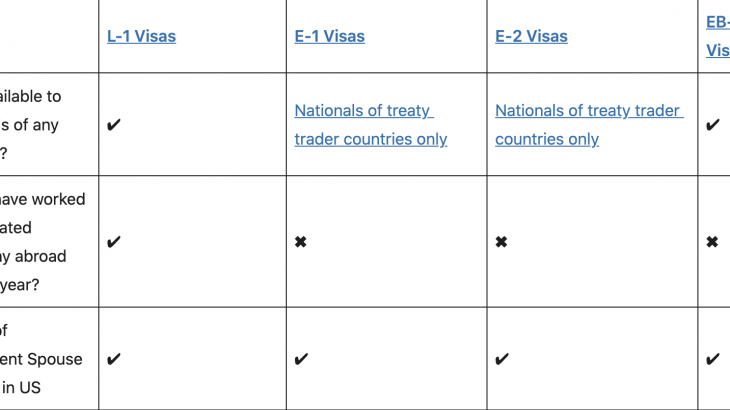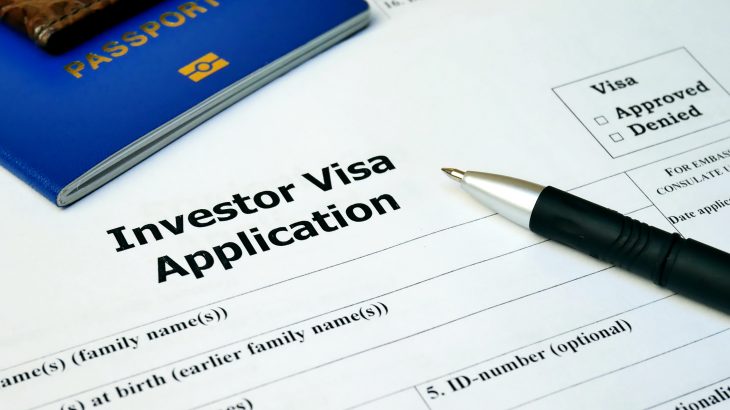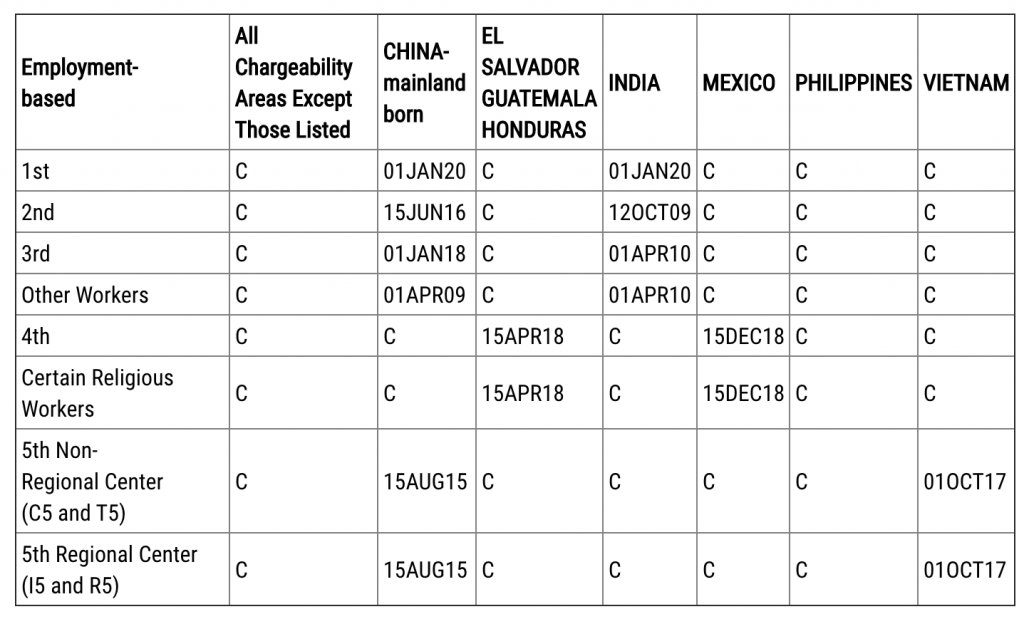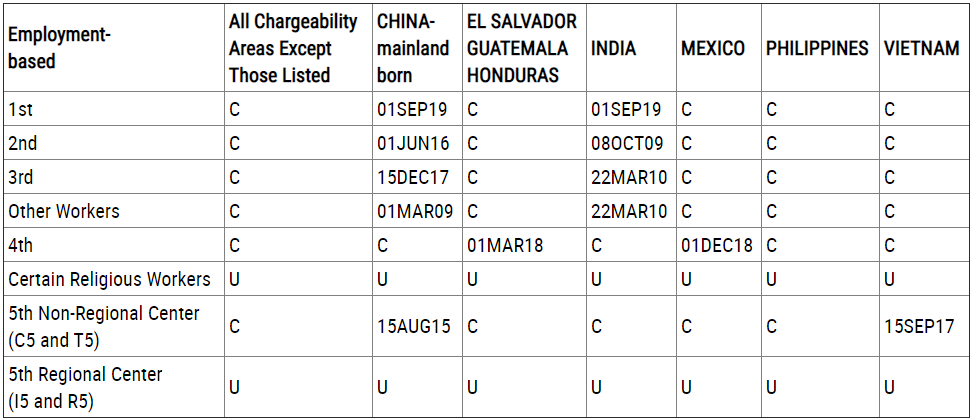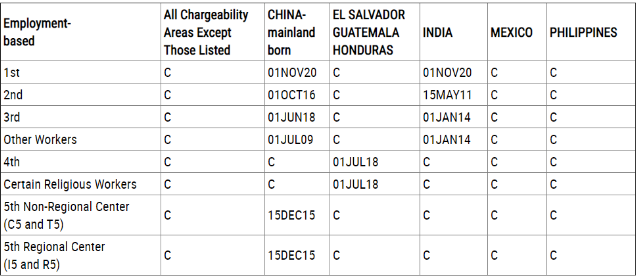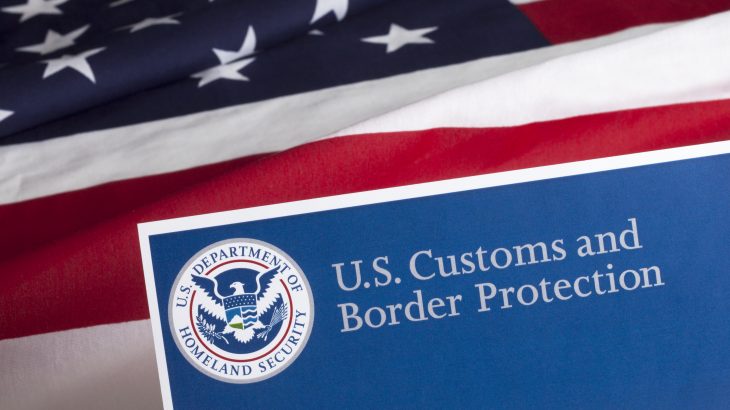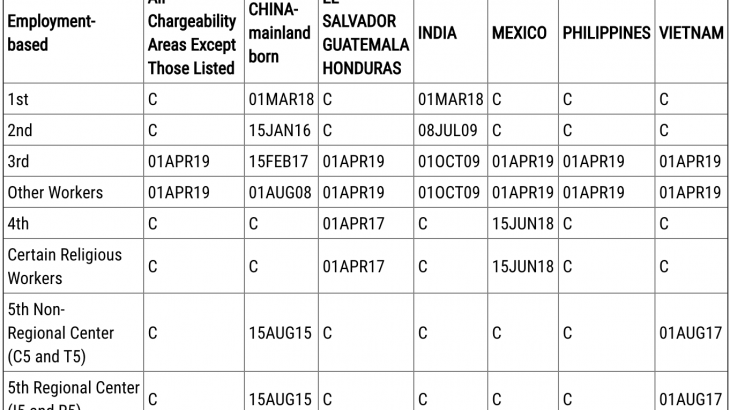Our firm has helped hundreds of business owners and families move to the United States on EB-5, E-2 and L-1 visas. Which visa is best depends entirely on your unique personal circumstances. We recommend every new client have a free consultation with our team to discuss the various options in light of their personal goals, budgets and interests.
| L-1 Visas | E-1 Visas | E-2 Visas | EB-5 Visas | |
| Visa available to nationals of any country? | ✔ | Nationals of treaty trader countries only | Nationals of treaty trader countries only | ✔ |
| Must I have worked for a related company abroad for one year? | ✔ | ✖ | ✖ | ✖ |
| Ability of dependent Spouse to work in US | ✔ | ✔ | ✔ | ✔ |
| Can the visa be renewed into perpetuity assuming I re-qualify? | ✖ | ✔ | ✔ | ✔ |
| Is a business plan a very key element of a successful application? | ✔ | ✔ | ✔ | ✔ |
| Minimum investment Required | Sufficient to operate valid foreign business and US office or business entity | No theoretical minimum, but enough investment to create a real, viable, business | Sufficient to fund business enterprise, generally > $100,000 although less is possible | Either USD 900,000 or USD 1,800,000 |
Visa Duration
One of the key differences is the length of time you can remain in the United States on each visa. The EB-5 visa leads directly to a Green Card (permanent residency). This means you can stay in the United States permanently until such a time as you opt to surrender your Green Card or apply to naturalize as a US citizen.
The L-1 visa and the E-2 visa are both non-immigrant visas. These do not offer permanent residency, but the E-2 visa is perhaps the next best thing because you can renew it indefinitely. Unlimited renewals means that you could technically live in the United States forever, provided the underlying business remains in operation.
The L-1 Visa is renewable up to a maximum of seven years for the L-1A visa and five years for the L-1B visa. After this time you would need to leave the US or transition to another visa or apply for a Green Card. It is best to discuss your options with an L-1 Visa attorney. Good fits for the L-1 visa are the EB-1(c) visa or the EB-3 visa. You can of course, also explore options for transitioning to a Green Card from an E-2 visa if you wish to make your presence in the US more permanent and not tied to the E-2 business.
The amount of time granted on your initial L-1 and E-2 visa will vary depending upon where you are from. Each country has a so-called reciprocity schedule which dictates the maximum visa validity period. Note that your visa might not be granted for the full period listed under your particular country. The authorities may wish you to return sooner to check on the status of your business. For example, “New Office L-1 visas” are granted for just a year initially, so checks on your progress can be made.
Investment Requirements
Each visa comes with a different associated investment requirement. The EB-5 Immigrant Investor Visa – as the name suggests – offers a Green Card by investment. The investment requirements are $900,000 for investments in a Targeted Employment Area (TEA) and $1.8 million outside these areas. In practice, the Regional Centers who manage the vast majority of EB-5 investments all work in TEAs and so only the $900,000 applies. If you wish to do Direct EB-5, we would need to make sure the investment is placed in a TEA to qualify for the lower amount.
By conducting due diligence on the Regional Center and its project, an EB-5 investor can mitigate risks not only to the Green Card but also to the return of your capital. Most Regional Centers offer very low rates of interest (in many ways the Green Card itself is the return on the investment). By investing with a reputable Regional Center in a reliable project there is no reason why the investor should not see the return of their capital after several years.
There is no fixed investment requirement for the E-2 Visa. A good rule of thumb is that it should be in excess of $100,000 and must be appropriate for the business you are proposing to start or acquire. We have seen some successful E-2 applicants for less than $100,000, so we encourage you to contact us regardless. The investment does not only need to be cash – it can also be in stocks of inventory, patents, equipment etc.
The L-1 visa does not require investment if you are simply transferring from the overseas branch to the existing branch of a multinational company. New Office L-1 visas inevitably require investment to set up and grow the new US office. This needs to be suitable to the needs of the business.
Work Authorization
The EB-5 visa offers complete freedom to work (or not work) in the United States. A single application/investment can include not just the applicant but any spouse and children under the age of 21. Each family member receives their own Green Card meaning they are free to work in the United States. We find many of our EB-5 clients are motivated by their children university education and work prospects after graduation.
The primary applicant for the E-2 and L-1 visas are obviously required to work in the role they moved to the US to fulfil. Spouses of these visa holders, however, can apply for work authorization in the United States. This offers a lot more employment flexibility than the popular H-1B visa for example, since you are not tied to a particular employer. As non permanent residents, you are only taxed on your US earnings.
There are many different pros and cons to each of these visa categories. It is vital to discuss your personal circumstances with our team so we can take you through every eventuality and thereby determine the best visa for you and your family.
This article is published for clients, friends and other interested visitors for information purposes only. The contents of the article do not constitute legal advice and do not necessarily reflect the opinions of Davies & Associates or any of its attorneys, staff or clients. External links are not an endorsement of the content.

























